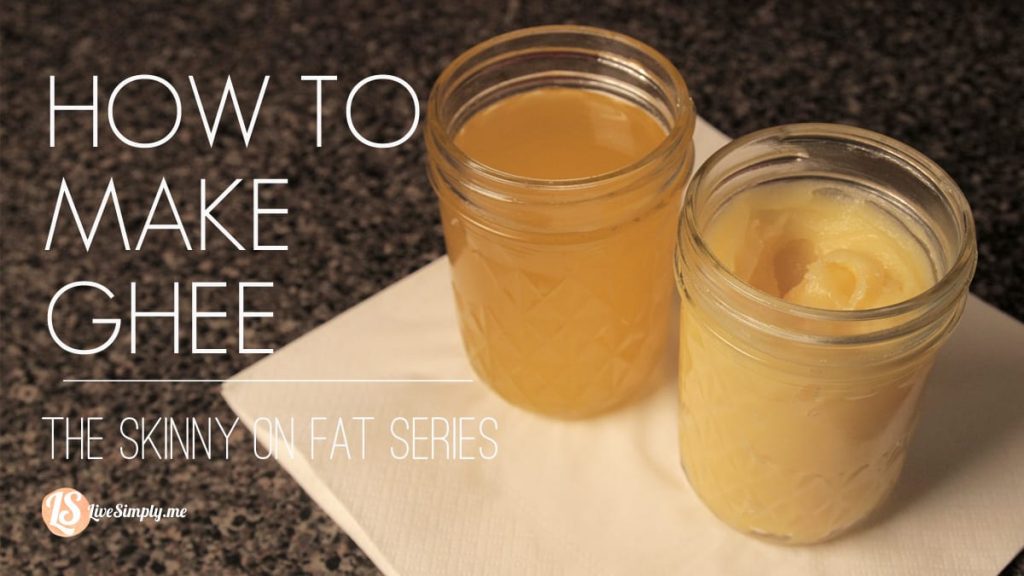I have a great love for butter.
Seriously, what is better than pastured butter?
Rich, creamy, yellow butter!
Would your mind be totally blown if I told you I have found something even better than butter?
I know, crazy, but it’s true.
Rich, creamy, nutty, and sweet. The nourishing goodness of butter without the need for refrigeration.
Sound too good to be true?
Let me introduce you to the goodness and wonder of ghee.
What is ghee?
Ghee is butter that has undergone a slow careful heating process to remove all the milk fat solids, moisture, and any impurities. The end result is a butter with a rich, buttery, sweet, nutty taste that has been clarified and is now self-stable requiring no refrigeration. Ghee is easy to digest due to this clarification process. Ghee has a very high smoke point which makes it wonderful for high temp. cooking. Butter burns quickly when heated leaving a brown butter with a burnt taste (yuck). Ghee retains its golden color and nutty, rich taste even when heated to very high temperatures.
Ghee is known as a sacred food in many parts of the world, including India where it is regarded as essential to a healthy diet, chocked full of nutrients and healing properties. Loaded with omega 3 and 9 fatty-acids and if made from pastured butter contains a large amount of CLA. Consuming ghee can help keep healthy skin, nails, and promote energy as it’s loaded with vitamins and minerals such as vitamins A, E, K, and D.
Due to the clarification of ghee and the removal of milk fat solids, people who don’t tolerate dairy, often consume ghee and even find it a healing food.
Yes, ghee has amazing health benefits, but the flavor of ghee is out of this world! Incredibly sweet, nutty, perfectly amazing! Once you have tasted the creamy, rich flavor ghee offers you will wonder how you’ve missed out on such goodness for so long.
It’s mind-blowing goodness.
Mind-blowing goodness that is simple to make in your own kitchen and requires only thirty minutes of time.
What you will need:
- Pastured unsalted butter (I use this butter)
- Saucepan (like this)
- Cheesecloth (where to buy)
- Glass storage jar (where to buy)
How to:
Ghee is super easy to make and requires about thirty minutes of active time in the kitchen.
Watch the video below for a full tutorial.
Ghee is shelf stable and does not require refrigeration. Keep on the counter in a sealed glass jar and use for cooking, baking, and to spread on toast or your favorite bread, like this one.
Before we part ways today, let me say a huge CONGRATS to the winner of the Ninja Pro-Blender GIVEAWAY.
Debra J. you are the winner!
Please contact me, here, within the next 48 hours to claim your prize.
I warmly invite you to join our Facebook community, be inspired on Pinterest, and subscribe to the blog.


Hi Kristin, this is going to be my first time to make ghee. I just wanted to know on the time. When you said the process in cooking ghee will take a total of 30 mins is that in low heat setting?
Hey Michelle, Yes, that’s on a low setting. Low settings vary from oven to oven, so the time may vary–just keep an eye on it so it doesn’t burn.
how long is it shelve stable?
Hi Cindy, The ghee will keep up to six months on the shelf.
How long should the whole process take?
It will take around 30 minutes.
Hi Kristen! Love your site. Quick question, I generally can only find Organic Valley Pastured lightly salted butter in my area, would that work for making ghee? I know you said unsalted in your tutorial. Thank you!
Thank you :). You can use salted butter, you just have to watch it very closely as it can burn much easier.
i have a dairy intolerance and ghee has been a lifesaver. i have made ghee a few times now and have had trouble getting it to completely set. i popped my latest batch in the fridge (i live in a slightly warmed climate) and when taken out it splits a little, developing pools of liquids in places. have you had any experience with ghee that doesn’t set?
I haven’t had the issue of it not setting yet. Would it be possible that the butter needs to “cook” a bit longer and hasn’t fully reached the state of removing all the milk fat? Let me do asking to a few other foodie blog friends. I’ll ask if they have experienced that issue.
Do you have any experience or advice on using sweet butter vs. cultured butter to make ghee? I buy my butter from a raw diary farmer.
Yes, I often use fresh, raw butter. It will work as well using the same process.
Ghee, although a type of clarified butter, differs slightly in its production. The process of creating traditional clarified butter is complete once the water is evaporated and the fat (clarified butter) is separated from the milk solids. However, the production of ghee includes simmering (see Sautéing) the butter along with the milk solids so that they caramelize, which makes it nutty-tasting and aromatic.Your milk fat solids will brown. If they did not brown, you made clarified butter. If they browned, you made a type of clarified butter known as ghee.
Thank you. They were brown on the bottom and difficult to pick up in lighting. Yes, you are correct. Thanks for sharing.
Is there anything you can do with the butter fat, or do you just toss it?
You can mix them with honey for a treat or eat them or toss them.